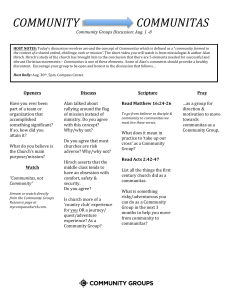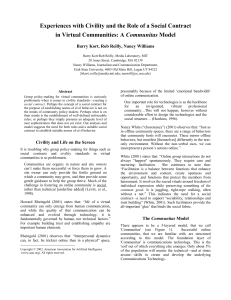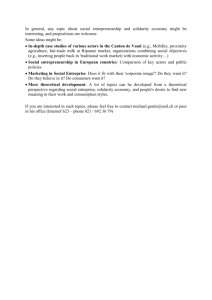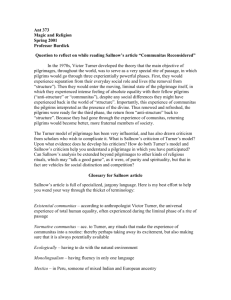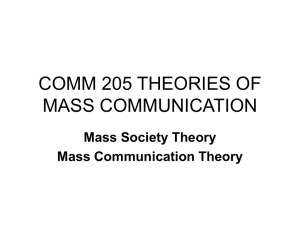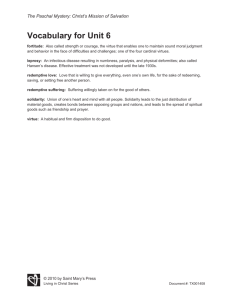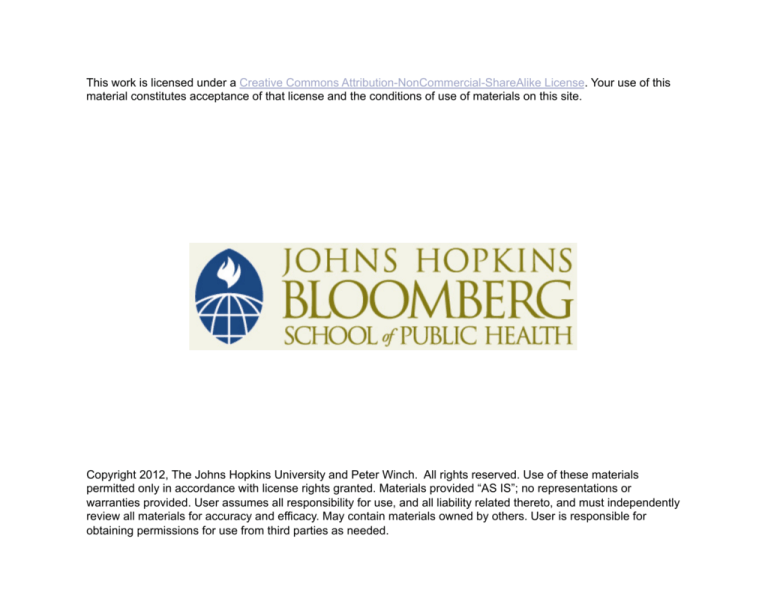
This work is licensed under a Creative Commons Attribution-NonCommercial-ShareAlike License. Your use of this
material constitutes acceptance of that license and the conditions of use of materials on this site.
Copyright 2012, The Johns Hopkins University and Peter Winch. All rights reserved. Use of these materials
permitted only in accordance with license rights granted. Materials provided “AS IS”; no representations or
warranties provided. User assumes all responsibility for use, and all liability related thereto, and must independently
review all materials for accuracy and efficacy. May contain materials owned by others. User is responsible for
obtaining permissions for use from third parties as needed.
Community and
community interventions
Peter Winch
Health Behavior Change at the Individual,
Household and Community Levels
224.689
Today’s lecture
1. Perspectives on community in sociology
and anthropology
2. Discussion of article by Demarest & Paul
3. Process for planning an intervention at the
community level
1. Perspectives on community in
sociology and anthropology
1. Perspectives on community in
sociology and anthropology
Community-level interventions in public
health often carry embedded in them:
– Models for what a community is
– Assumptions for how communities
function
I will present some perspectives on
community from anthropology and
sociology, then look at the article by
Demarest & Paul and see how they apply
1. Perspectives on community in
sociology and anthropology
This class: Dichotomies that have been
proposed in the past
– van Tönnies
– Durkheim
– Turner
Next class: The current “anti-dichotomy”
approach to thinking about community
– Social capital
Community as form
of social organization:
van Tönnies and Durkheim
Early thinkers on community
Early thinkers on community include Émile
Durkheim and Ferdinand van Tönnies
Although concepts are now dated, they
continue to have influence on disciplinary
boundaries and framing of questions
Ferdinand van Tönnies
German sociologist, 1855-1936
One founder of sociology as a discipline
Best known for his book “Gemeinschaft und
Gesellschaft” published in 1887
Original German words commonly used to
distinguish between everyday meanings of
community and society
Gemeinschaft und Gesellschaft
Gemeinschaft ~ Community
– Gemein = common
Gesellschaft ~ Society / civil society
– Geselle = partner or stockholder in a
company or firm
Gemeinschaft/community
Small-scale groups
Everyone knows everyone else, face-toface relationships are paramount
Family and kin ties are central
Low to moderate division of labor e.g. all
families are engaged in fishing or
agriculture or hunting
Relatively small-scale social institutions
Collective sense of loyalty, shared values
and shared aspirations
Gesellschaft/society
Members may have little in common, don’t
share values, but they share a project
which serves self-interest of the individuals
– Product or service
– Citizenship
– Protection against outside forces
Elaborate division of labor
Divergent aspirations
Susceptible to class, racial and ethnic
conflict
Significance of this dichotomy
Contributed to the disciplinary division of
labor starting in the 1800s
– Anthropologists to study people living in
a Gemeinschaft (‘traditional’ community)
– Sociologists to study people living in a
Gesellschaft (modern society)
Although an older idea, even today
captures assumptions many people make in
design of community interventions
Significance of this dichotomy
Example: It is common for people to
assume that communities have many
characteristics of a Gemeinschaft,
including:
– Everyone knows everyone else (dense
social network)
– Small-scale social institutions
– Collective sense of loyalty
– Shared values
Early thinkers on community:
Émile Durkheim
Émile Durkheim
French sociologist, 1858-1917
Seminal studies on crime, religion, suicide
Developed idea of organic and mechanical
solidarity in The Division of Labour in
Society (1893)
Mechanical and organic solidarity
Mechanical
solidarity
Classic
All of the subsistence
example farmers in a village in
a low-income
country, have very
similar working
conditions, affecting
by same climatic,
ecological and
economic conditions
Organic solidarity
Citizens of a modern,
industrialized country
who have very
different jobs, that
together contribute
to the larger society
through industrial
production, provision
of services etc.
Mechanical and organic solidarity
Mechanical
solidarity
Structural Based on
features
resemblances,
shared aspirations
Clan-based, later
territorial
Little inter-dependence
Social bonds relatively
weak
Relatively low
population
Organic solidarity
Based on division
of labor, divergent
aspirations
Equal opportunity,
individual rights
Much inter-dependency
Social bonds relatively
strong
Relatively high
population
Mechanical and organic solidarity
Mechanical
solidarity
Compare to: Gemeinschaft
Organic
solidarity
Gesellschaft
Structural
features
Based on division of
labour
Equal opportunity,
individual rights
Much interdependency
Social bonds
relatively strong
Relatively high
population
Differing
view from
van
Tönnies
Based on
resemblances
Clan-based, later
territorial
Little interdependence
Social bonds relatively
weak
Relatively low
population
Identify the kind of solidarity:
Scenario #2
Obstetrician
commiserates with
other obstetricians at
a conference about
the many different
pressures they all face
in their work
Obstetrician feels
close to all the other
health professionals
working in the
delivery ward, and
recognizes the value
of each one’s
contribution
Identify the kind of solidarity:
Climate change
All people living on the planet
Citizens of a small island state at risk due
to sea level rise
Citizens of USA
Identify the kind of solidarity:
Climate change
All people living on the planet
– Mechanical: We are all on the same
planet, breathe the same air, drink the
same water
– Organic: We are dependent on each
other. We each have a different role to
play in addressing the problem
Significance of this dichotomy
Limitation of Gemeinschaft-Gesellschaft
dichotomy is that you are in one or the
other but not both
In contrast, Mechanical-Organic Solidarity
dichotomy allows for people to experience
both kinds of solidarity, and consequently
to identify with multiple communities
Significance of this dichotomy
For public health, this suggests that
– we should evaluate the type of solidarity
that binds each community together,
– and this in turn may inform our choice
about which type of community we
should work with
If we had to choose one or the other, which
option is preferable for scenario #1?
Option #1: Work through professional
association (physicians, nurses)
– Task force of the association analyzes
the problem, makes recommendations
– Have members commit to implementing
recommendations of the task force
Option #2: Work with health care workers
in facilities to analyze the problem teamby-team and identify solutions
Final word on Durkheim
The terms mechanical and organic
solidarity are not found much in the current
literature
The underlying ideas have largely been
incorporated into the social capital
literature
– Solidarity Social capital
Dichotomies that have been
proposed in the past
van Tönnies
– Gemeinschaft and Gesellschaft
Durkheim
– Organic and Mechanical Solidarity
Turner
– Communitas versus hierarchy
Victor Turner: Communitas
versus hierarchy
Victor Turner
Scottish anthropologist, 1920-1983
Studied Ndembu in Zambia
Wrote on rites of passage and liminality
– Initiation ceremonies for adolescents
– Marriage ceremonies
– Funerals
Developed concept of communitas
– Communitas contrasted with hierarchy
Communitas
Victor Turner chose the Latin word to
distinguish his concept from the everyday
meaning of community
Usual condition of people is hierarchy
Communitas is a temporary state when
members of a group have relations of
equality
Communitas
Communitas is a state of being, rather than
a geographic location or a group of people
People living in communitas are in a
transitional or liminal state from one status
or situation to another
Communitas
The emotional experience of communitas:
– community spirit
– solidarity
– togetherness
Communitas contrasted with:
– Structure
– Hierarchy (versus humility)
– Secular, everyday life (versus sacred life)
Circumstances under which
communitas can come into being
Events affecting an entire group of people:
Storms, wars, oppressive government
– Tsunami/earthquake in Japan
Revolutions, democratic movements, Arab
Spring, Occupy Wall Street movement
Rites of passage: coming-of-age rituals,
weddings
Holidays: Thanksgiving, Holy Week,
Ramadan
Pilgrimages
Communitas example:
Jencson 2001
Analysis of Red River Valley Flood of 1997
Found that many aspects of communitas typically
associated with rituals also occurred during the
community response to the flood:
– Shared hardship and sense of belonging
– Simplification of life, regular activities on hold
– Spiritual dimension to the experience
– Erasure of normal hierarchical relations and
gender roles
Difficult to sustain communitas
Some seek to form broader social
movements to sustain the communitas, but
these quickly become hierarchical
Similar problem with attempts to
“institutionalize” revolutions
– Mexico’s Partido Revolucionario
Institucional
– Occupy Wall Street
– Arab Spring
Why doesn’t
communitas last very long?
Turner: Why doesn’t
communitas last very long?
People find it stressful to remain in a
permanent state of equality with others
– Don’t know the rules, need to be
constantly inventing the rules
– Hard to make decisions
– Difficult to achieve individual goals
More willing to suspend the normal rules
while threat is present. When threat
recedes, tendency to go back to the rules.
Significance of the communitashierarchy dichotomy
Suggests that there is no “steady state” for
community interventions
– Ebb and flow of community engagement
should be seen as normal, rather than
as a deviation
– Unrealistic to expect that communities
can be mobilized, and stay mobilized
– Community-based interventions are not
inherently sustainable
Significance of the communitashierarchy dichotomy
Have a long-term vision for the role of the
community
– Plan for periods of both communitas
and hierarchy
– Knowing that communitas will not last
forever, have necessary resources and
materials in place to make the most of
the moment establish a new pattern
or new equilibrium
Significance for environmental
protection interventions
2. Discussion of article
by Demarest & Paul
Carrie in San Pedro la Laguna
What is the model of community implicit in
the approach?
What is primary locus of change?
What are obstacles to change assumed by
the external change agent?
What is strategy for change?
Schwartz 1981, Table 1: Community
development, community study and conflict
perspectives: A comparison
Community development (CD)
Around for a long time, tremendous diversity in
actual methods and procedures
Common elements:
– Work with communities to develop plans
based on their ‘felt needs’
– Increase local self-sufficiency
– Enhance local capacities for problem-solving
– Use democratic methods
– Build on cultural precedents/strengths
– Improve quality of life
Schwartz 1981, Table 1
Community
Development
Conflict Perspective
Object Local community in Larger society and
of study holistic, functionalist environment and their
terms
relations to local
community
Primary Tradition, identity
Macrolevel political
locus of and culture
and economic
change
structures and
environment
Perspectives on community
in public health
People who talk about community
participation and participatory research
often have a view of community that is
close to Tönnies’ Gemeinschaft
This is in contrast to views of community
among many social scientists who focus on
hierarchy, conflict, power relations rather a
homogeneous group with shared
aspirations
Recommendations to avoid Carrietype situations (Paul 1984 p 192)
1. If a community’s need is already
represented by competent leadership,
accept their form of leadership; do not
impose your own concept of proper
representation.
2. Think twice before trying to create a
community-wide committee, especially in
the case of a politically-polarized
community.
Recommendations to avoid Carrietype situations (Paul 1984 p 192)
3. If a community committee is charged with
decision-making, serve as its consultant, not its
director.
4. If you are really the director with the ultimate
authority, make your position clear at the
outset; do not build up false expectations about
community self-determination.
– This is the most commonly-violated of the
commandments
– Common when you hire a young and
enthusiastic project director
Recommendations to avoid Carrietype situations (Paul 1984 p 192)
5. Community development specialists would
do well to spend more time learning how
the community is organized, and less time
trying to organize it.
– Formative research
Today’s lecture
1. Perspectives on community in sociology
and anthropology
2. Discussion of article by Demarest &
Paul
3. Process for planning an intervention at the
community level
3. Process for planning an
intervention at the community level
The challenges to implementing
interventions at higher levels
What does it mean to intervene at the
community or other higher level?
Do people even feel they are a part of
these higher-level units?
What is the best way to motivate groups,
rather than individuals?
Decreasing awareness and ownership of
problems at higher levels
Individual
Greater awareness &
ownership of problem, greater
commitment to action
Household
Community
Less awareness & ownership of
problem, less commitment to
action
Decreasing awareness and ownership of
problems at higher levels
Individual
– “My shirt is
stained”
Greater awareness &
ownership of problem, greater
commitment to action
Household
– “The dishes
are dirty”
Community
– “There is
Less
awareness
&
ownership
of
trash in the
problem, less commitment to
park”
action
Typical situation at the community
level (or other higher level)
Low sense of identity with the group, low
ownership
– “What do I have to do with these people?”
– “It’s really not my problem”
Low awareness
– “I really don’t know how common it is”
Low commitment to action
– “I’m not going to do anything, the mayor/leader
should do something”
Low perceived community efficacy
– “Nobody ever does anything about these problems
anyway”
– “The neighbors are lazy, they don’t do anything, they
throw garbage all over”
How do we organize action
at higher levels?
1. Build sense of identity and solidarity with the
unit of implementation
2. Assessment/awareness-raising
3. Planning/decision-making/preparation
4. Implementation of plans/practicing behaviors
5. Monitoring/feedback
– Variants on this process known by many
different terms e.g. Community Action Cycle
in the Community Mobilization literature
1. Build sense of identity and solidarity with
the unit of implementation
Sometimes public health works with
groups/communities that are well
recognized and accepted, and that people
identify with
Other times, public health may choose to
create a group/community that people did
not previously recognize or identify with
Choice of units of intervention
People already
identify with
Neighborhood
Institution or
employer e.g. health
care facility
Religious or ethnic
group
People in need of a
service
People didn’t already
identify with
Catchment area for
health facility or other
administrative boundary
People sharing an
individual risk factor or
an environmental risk
People sharing
responsibility for a
problem
Example of non-identification with
a community definition
Watersheds are the obvious (to
environmentalists) unit of action for
improving water quality, decreasing
hazardous runoff etc.
Big problem: Very few people realize what
watershed they are in. Even if they do
know, it isn’t an important unit of identity
for them.
Warner & Hanna’s Plan of the City and
Environs of Baltimore, 1801
Herring Run watershed
Watershed associations in
Baltimore
There were 5 watershed associations:
– Jones Falls Watershed Association
– Herring Run Watershed Association
– Gwynns Falls Watershed Association
– Baltimore Harbor Watershed Association
– Baltimore Harbor WATERKEEPER
Merged in 2010 into one association:
– www.bluewaterbaltimore.org
How to build identity
with a watershed?
How to build identity
with a watershed?
Maps
– Created by outside experts
– Community-created maps
Focus on shared resources: Parks, areas of
scenic beauty, fishing
Focus on shared threats: Runoff, toxic
waste
How do we organize action
at higher levels?
1. Build sense of identity and solidarity
with the unit of implementation
2. Assessment/awareness-raising
3. Planning/decision-making/preparation
4. Implementation of plans/practicing
behaviors
5. Monitoring/feedback
2. Assessment/
awareness-raising
Assessment/awareness-raising:
Purposes
Awareness: Make people aware of the
size or scale of the problem
– “Empirical efficacy” idea Try to
demonstrate visible impact of situation
Ownership: Promote sense of ownership
of the problem
Commitment: Build commitment to do
something about the problem
Assessment/awareness-raising:
Methods
Share existing data on the problem
Have people/group collect their own data
about the problem and analyze it
– Best if problem is visible, can be
assessed without specialized methods
Collaborative data collection and analysis
between people/group and outside expert
– Hidden problems e.g. prevalence of
viruses or parasites, presence of toxins
Assessment/awareness-raising at
different levels
Individual
Individual medical examination, HIV test
Individual behavioral or risk factor
assessment: In-person or online
Increased knowledge self-awareness (?)
Household
Survey for mosquito larval habitats in the
home by MOH employee, adult or child
Calculation of volume of feces contributed
by each household (CLTS Bangladesh)
Community Sharing of data & results with communities
Various forms of community-based
participatory research e.g. CLTS and PRA
(More later in this lecture)
Individual online assessment:
www.eatlowcarbon.org
Individual online assessment:
www.carbonfootprint.com
Assessment/awareness-raising for
different scenarios
Scenario 1
Malaria TZ
Calculate number of cases treated
incorrectly for malaria per month in health
facility and cost of incorrect treatments
Scenario 2
Micronutrients
Scenario 3
Energy
Involve community members in conducting
o Nutritional/anthropometric survey
o Household food security survey
Inventory of household environmental
impact: water use, waste & greenhouse gas
production
Measure cost to household of current
pattern of energy use
How do we organize action
at higher levels?
1. Build sense of identity and solidarity
with the unit of implementation
2. Assessment/awareness-raising
3. Planning/decision-making/preparation
4. Implementation of plans/practicing
behaviors
5. Monitoring/feedback
3. Planning/decision-making
Planning/decision-making:
Purposes
What/how: Decide what needs to be done, how
to do it, what supplies/commodities are needed
Who: Decide who is going to do it
– At household level, sometimes the new
behavior does not correspond to any of the
existing household roles, need to determine
who is best person to do it
– At community level, need to determine who
will organize/supervise the action and who
will do it
Support: Decide how others can support the
people taking the action
Planning/decision-making at
different levels
Individual
Household
Individual counseling, planning to
change individual behaviors
Home visits, engage entire
household in discussing situation and
planning solutions
Community Community-wide meetings or
meetings with community groups,
development of plan to address
community problems
What has to happen during planning and
implementation to achieve behavior change
Individual
Increase self-efficacy and skills
Information and skills appropriate to
stage of change
Household Redefine/reallocate roles of different
household members
Changes in allocation of resources
Reorganization of household space
Community Community committees to implement
solutions, monitor progress
Change in community norms,
collective penalties for violating rules
Planning/decision-making for
different scenarios
Scenario 1
Malaria TZ
Scenario 2
Micronutrients
Scenario 3
Energy
Who will do tests, and interpret results?
Will test results be shared with patients,
who will share results and how?
What will be done with febrile patients who
test negative for malaria?
How to distribute, promote and explain
proper use of micronutrient supplements?
What actions can be taken at the
household level?
Who will be responsible for taking these
actions?
How do we organize action
at higher levels?
1. Build sense of identity and solidarity with
the unit of implementation
2. Assessment/awareness-raising
3. Planning/decision-making/preparation
4. Implementation of plans/practicing
behaviors
5. Monitoring/feedback
5. Monitoring/feedback
Monitoring/feedback: Purposes
Track progress, indicate to people what has
been done and what hasn’t been done
Identify gaps/problems that need to be
addressed
Increase self-efficacy of people/group that
they are able to implement the plan
Demonstrate tangible benefits from
practicing the new behaviors
Monitoring/feedback
at different levels
Individual
Household
Follow-up counseling to monitor progress
On-going individual self-assessment
Follow-up household surveys or
assessments
Self-assessments by households
Community Feedback of data to communities
On-going assessments and monitoring by
communities
Monitoring/feedback
for different scenarios
Scenario 1
Malaria TZ
Scenario 2
Micronutrients
Scenario 3
Energy
Proportion testing positive and negative for
malaria receiving treatment
Savings from not treating negative cases
Distribution and consumption of
supplements
Child nutritional status
Household monitoring of energy use
Hasn’t proven popular
Question #2
Concepts & models
• Emic and etic terminology
• Models of illness etiology
• Standards of efficacy
• Individual and multi-level
behavior change models
• Social networks, diffusion of
innovations, social marketing
• Risk communication
• Household and kinship
• Community and society
• Social capital
• Health systems
Question #3
Assessment
Planning/
decision-making
Monitoring
Methodologies that incorporate
assessment, planning, implementation
& monitoring steps
Community level
– Community Led Total Sanitation (CLTS)
– Various forms of participatory research
Health facility level
– Various quality assurance approaches
District and national level
– Various assessment/planning
approaches
Community Led Total Sanitation
(CLTS) http://www.eldis.org/go/topics/dossiers/
livelihoods-connect&id=37507&type=Document
Community Led Total Sanitation
(CLTS)
Participatory process to incite a communitywide movement to eliminate open defecation,
build latrines etc.
Different ways of naming the stages
– Pre-triggering, triggering, post-triggering
– Ignition, facilitation, explosion
Key innovation is to trigger disgust with lack
of sanitation during assessment stage,
leading to greater commitment to change
CLTS in Bangladesh (1)
Ignition: Assessment/awareness raising
– Defecation area transect with visitors
Disgust triggers consensus for action
– Sanitation mapping, collective
calculation and flow diagrams
• Calculation of feces production by
each household and by entire
community
• Diagrams of flow of contamination
from sites of defecation to water and
food
CLTS in Bangladesh (2)
Collective planning
– Formation of sanitation committee
– Household plans to stop open defecation
– Collective penalties for open defecation
Innovative models for toilets
Spread of innovations to other villages

